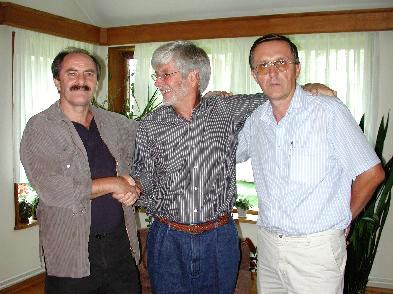The Artists

Most of these artists come from the region of Podravina (famous for the small town of Hlebine where this art form got started) in the northern part of the country on the Drava River near the Hungarian border, about 50 miles from Zagreb, the capital of Croatia.
The Great Masters
- Ivan Generalic
- Ivan Rabuzin
- Ivan Vecenaj
- Ivan Lackovic-Croata
- Mijo Kovacic
- Josip Generalic
- Dragan Gazi
The Artists
- Ivan Andrasic
- Drago (Carlo) Bobovec
- Martin Djukin
- Stjepan Djukin
- Vladimir Dolonec
- Mladen Dolovski
- Franjo Filipovic
- Ivica Fister
- Christina Fister
- Goran Generalic
- Milan Generalic
- Josip Greguric
- Milan Horvat-Hlebinski
- Mirko Horvat
- Zlatko Huzjak
- Vladimir Ivancan
- Stjepan Ivanec
- Djuro Jakovic
- Drago Jurak
- Franjo Klopotan
- Zlatko Kolarec
- Martin Kopricanec
 Drago Kovacic
Drago Kovacic- Ico Kovacic
- Martin Mehkek
- Boris Mihokovic
- Milan Nadj
- Marijan Napan
- Miroslav Pintar
- Sonja Pintar
- Djuro Popec
- Kresimir Safar
- Zvonko Sigetic
- Ivan Stefanek
- Mato Toth
- Nikola Vecenaj Leportinov
- Franjo Vujcec
- Kamilo Vujcic
- Biserka Zlatar
- Mirko Zovko
Some History
To make a long story short, the artist Krsto Hegedusic found two young farmers in the late 1920s (Ivan Generalic and Franjo Mraz) painting in Hlebine. He taught them the technique of painting on the reverse side of glass. The reason for painting on glass was that the colors are much more vivid than anything you will ever see on canvas. The signature had to go on first. All of the main images and foreground needed to be placed on the glass next so that afterward there would be nothing covered up by the final touches of the painting. After each stage, the painting must be left to completely dry so a single painting could turn into a project that lasted from days to years.

Well, there is a history of about 100 years of this form of art from this part of the world, but let’s just say that these artists from "The Hlebine School" started out painting what might be called "social protest" art because of the harsh injustices placed on the peasants from an overly repressive, dictatorial government. They painted anti-government scenes. For a period of about 7 years when it was forbidden to create this type of art, the artists were banned, and only the bravest of them continued to paint in what was an underground movement.
Hegedusic thought that the only reason for the art should be to protest government actions, but many of the young artists decided that there were other things they would prefer to paint. Generalic, Mraz and others began to paint things they knew and lived: farm scenes, winter scenes and life in general in the countryside of Podravina. Eventually there came a split between Hegedisic and the Hlebine School painters, which had grown to include many more than simply Generalic and Mraz, and they basically parted ways. Not meaning to skip a lot of history, but for the sake of brevity, I will bring us up to the present.
The "Masters"
The Masters of the movement begin with "The Four Ivans": Ivan Generalic, Ivan Rabuzin, Ivan Vecenaj and Ivan Lackovic Croata as well as Mijo Kovacic, Mirko Virius, Franjo Filipovic, Franjo Klopotan, Dragan Gazi, Josip Generalic (Ivan's son) and a several others who have paintings in museums around the world.

Present Time
Today, there are more than 100 of these artists painting on glass! The subject matter and individual styles vary much more than they did in the infancy of this movement. I personally feel that the caliber of art in general has gotten better with the passing of time. The "technique" is being perfected.
You can collect the newer generations of these artists (second- and third-generations) without spending a fortune. These are unique originals, not serigraphs, lithographs, giclee prints or photographs and from some of the most talented artists in the world!
The "Masters" and Newer Generations
Let’s review those who are called the Masters of the movement, beginning with "The Four Ivans": Ivan Generalic, Ivan Rabuzin, Ivan Vecenaj and Ivan Lackovic Croata as well as Mijo Kovacic, Mirko Virius, Franjo Filipovic, Franjo Klopotan, Dragan Gazi, Josip Generalic (Ivan's son) and perhaps a few others have paintings that could certainly become museum pieces (and many are!) albeit they are considerably more expensive than the newer generations. More expensive, yes, but still affordable for many! That's what's great about this thing I call "niche art from emerging nations." They are still affordable!

